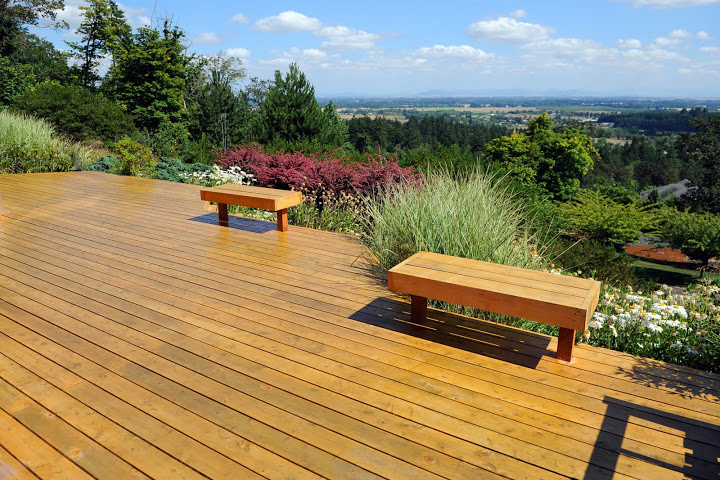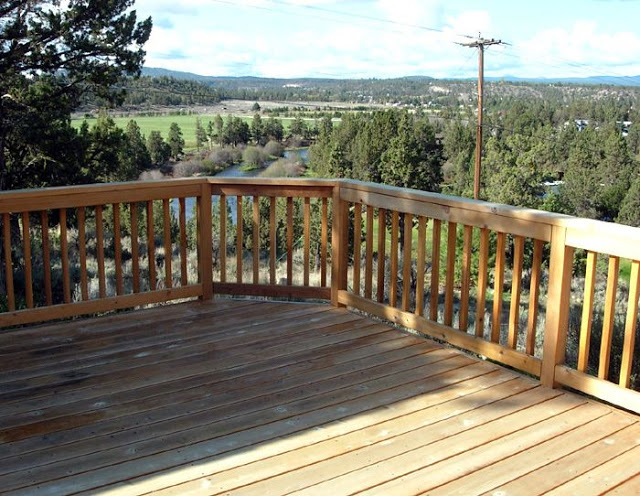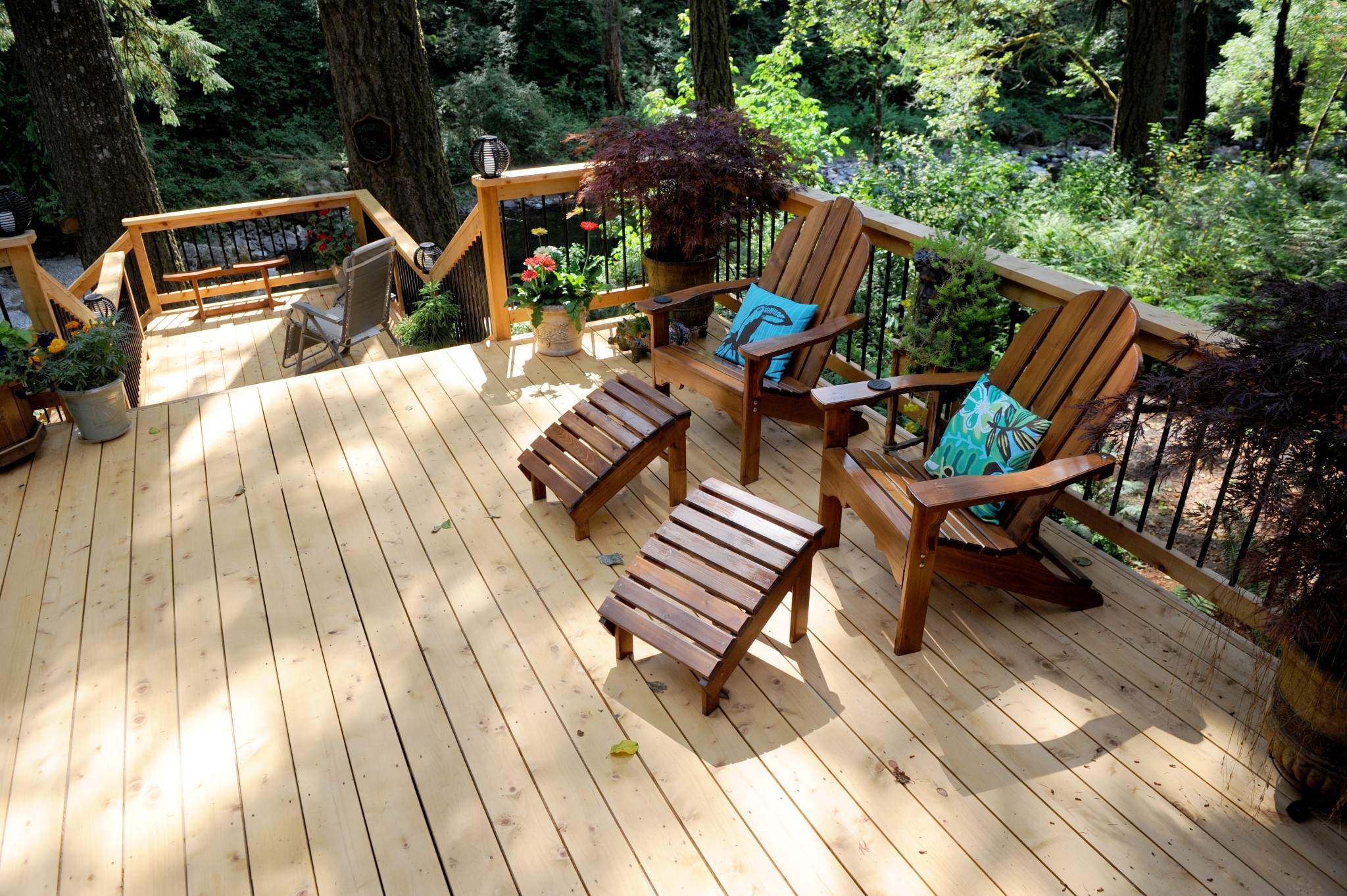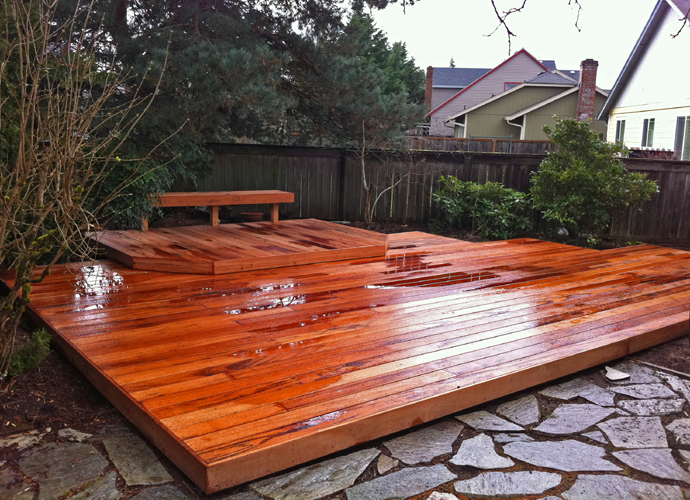This guest post is by Decking & Fencing Professional, Nick Marshall
Fall: It brings to mind the brilliance of changing leaves, the glow of Jack-o-Lanterns, and the bounty of the harvest. But for a wood deck, fall also holds an insidious danger: moisture. Chilly mornings and cold nights bring more moisture to the air, and to every exterior surface, including your cedar deck.
And more moisture means more opportunity for mold and mildew growth.
The growth of mold and mildew is a real problem because these microscopic forms of life break apart wood fiber and cause rot.
Mold and Mildew: Wood Deck Killers
Over time, a moldy, mildew-ridden deck will turn into a splintery eyesore. Some prefer this rustic look, but for those who wish to enjoy a bright, clean, safe deck for the maximum amount of time, preventing moisture infiltration is a top priority.
To get a top ROI on your decking area extension, it’s key to shield your deck against moisture, via regular cleaning, sanding, and sealing. Most decking experts recommend carrying out this process every year or two; in more arid locales, every five years may suffice.
Every wood deck should be cleaned at least once a year using a bristle brush, soap, and water. It’s best to do this process in the driest days of summer, so that the wood will have a chance to dry out. Additionally, best maintenance practices call for keeping decking surfaces clear of debris, via sweeping or a leaf blower. If material has become stuck between deck boards (thereby preventing proper drainage), use a putty knife to remove it.

If mold and mildew have already taken hold, it’s possible to remove them using the following methods…
Cleaning Techniques for Removing Mold & Mildew from Wood Decks
For safety purposes, it’s best to wear protective eye-wear, a respiratory mask, and rubber gloves when removing mold from your deck. When thrown into the air, mold and mildew spores can cause allergic reactions and respiratory problems, so it’s best to play it safe and wear protective gear.
Mist the Entire Surface with Water
Avoid creating puddles where cleaning solutions can settle and lighten the wood’s surface.
Apply Bleach Solution to Kill Surface Mold and Mildew
A good ratio is ten parts water to one part bleach. Bleach may lighten the deck’s surface, so another option is to use a pre-made deck cleaning solution. Finally, the US EPA recommends a mild detergent as a good way to remove mold and mildew from wood.

Scrub, Sand or Pressure Clean Deck to Remove Roots
Mold and mildew are stubborn organisms; if you don’t remove their roots they will come back with a vengeance. Therefore, it’s crucial that you scrub, sand and/or pressure clean the deck’s surface after bleaching. Again, you can use a stiff-bristle brush for this job. If you opt for pressure cleaning, be sure to use a low-pressure setting to avoid causing damage. Or you can always hire out the job to a professional.
Apply Sealant that Contains Mildewcide
The sealant is the layer of protection that will prevent moisture infiltration going forward. You can select a sealant that also contains a stain, or a transparent sealant that allows the wood’s natural beauty to shine through. In any case, save yourself work down the road by ensuring that your sealant includes mildewcide to prevent future growth.
Leaves and Deck Stains
Fall also brings a dazzling cascade of leaves, which pose a different threat to your cedar decking. Leaves contain tannins, astringent organic chemicals that protect plants against insects, bacteria and even fire. Tannins are the reason why marsh water is murky brown—submerged leaves taint the water as tannins are released.

Chances are you’ve seen the ghostly silhouette of leaves on sidewalks around town—these are the tannin remnants of fallen leaves. The same tannins that stain concrete can cause brown or black stains on a wood deck. In the fall, wet leaves can adhere to the surface of decking, where they release their tannins into the wood.
Additionally, piles of leaves tend to trap moisture and cultivate mold and mildew growth, so for both stain prevention and overall deck maintenance, it’s best to sweep your decking area regularly throughout autumn.
If leaf stains do appear on your wood decking, don’t worry: It is possible to remove them by applying a brightener once dryer weather rolls around.
Preventing Deck Mold and Mildew Growth
Once your deck is clean and sealed against moisture, you can take the following preventative measures to protect against mold and mildew growth in the future…
Remove Potted Plants
Potted plants trap moisture on your deck’s surface. If you simply must have containers on your deck, make sure you move them around periodically, and add plant stands and pot feet to maximize circulation.
Maintain Excellent Circulation
Remove trapped debris between deck boards and move deck furniture around now and then to maximize airflow.
Check that Gutters don’t drip on Deck Surfaces
Improve your roof’s drainage system if necessary to divert water away from your decking area.
Maintain a Plant-free Zone around Your Deck
Over time, plant material that stays in contact with your deck will cause rot.
Sweep or Shovel Snow off Your Deck
As snow melts, moisture seeps into your deck surface, facilitating mold and mildew growth. A broom is best for snow removal, as it won’t leave scratches, as some metal snow shovels will.
A properly maintained deck is a thing of beauty. For a long-lasting deck that will provide years of enjoyment for your family, invest some time in keeping your deck moisture-free.

Nick Marshall is the General Manager of Rick’s Custom Fencing & Decking. Since 1980, the professionals at Rick’s Fencing have been designing & installing many styles of fences & deck to enhance their clients’ homes. Follow them on Facebook for other tips to care for your wood deck.


Thanks for the indispensable advice and tips on caring for your deck. We deal with mold quite a bit here in Florida, so your tips will prove most useful to share with our circles.